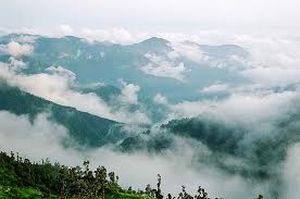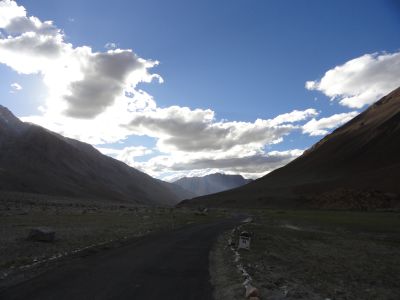In the mists that shroud the hills for days on end, tiny droplets slither down the fine needles of chir-pine crowns, form a drop and fall off, one by one, like a saline drip vanishing into the body of a patient on a hospital bed; all in silence except for the ‘plop’ on your umbrella should you be walking under these canopies.
When it rains, strings of water drops slide along electric lines and jump off from a low point creating a little puddle where they fall. Drenched mynas, vigorously shaking themselves and noisily cackling assemble on bare branches and neglected fences near bus stands and tea shop agglomerations, ever on the lookout for food. Wet, stray dogs, uncertainly half wagging their tails, imploring customers for crumbs at ‘dhabas’, move insecurely under and between tables, ready to quickly slink away to a safe distance at the slightest hint of any ‘threat’.
Having known humans from the beginning, the dogs will look back, linger and promptly return to wait for leftovers thrown at them. In markets, clogged drains overflow making the putative footpaths slushy and the potholes into deep brown micro-ponds. As older men and women pull up their pants/pyjamas or salwars to negotiate the wet footpaths, an occasional scream or curse is heard as speeding cars or motorcycles splash sludge on stressed pedestrians.
Sometimes the mists lift and the clouds break and the warm monsoon Sun streams through, much to the delight of fully wet life below. With the slightest of breeze, foliage stirs and shakes off the dripping water like maidens drying their tresses after a head bath. Soon little puffs of mist reform in the valley bottoms and slowly drift upwards to the sky, even as swollen streams gurgle and tumble down hurriedly towards the sea.
Cars parked haphazardly along roads looked washed as they gleam in the Sun. Trees, shrubs and grasses displaying the many shades and nuances of green exult in this season of growth, even as they are swarmed by armies of insects doggedly pursuing their specific life cycles; and, elsewhere among dense foliage fireflies incessantly twinkle in the dark.
Anticipating the explosion of insect life during the monsoon, the ample spider diversity seems to work overtime and build the most intricate and exquisite cobwebs in every conceivable nook and cranny; and then stoically wait hoping to entice with their works of art, the curious and gullible flying fauna. Wild fruits form, ripen and drop; or are ‘accessed’ prematurely by birds, monkeys or children.
Clouds in the monsoon, in stillness or in motion, can hold one spellbound for hours, bringing back memories and melodies bygone. The interplay of forms, shapes, shades and light is endless and fascinating.
In the mountains, especially when you are perched on a ridge, the evening rendezvous of clouds and light can transform ordinary sunsets into the most spectacularly beautiful and romantic of experiences.
Clear visibility during the rainy season etches each unique and wonderful sunset, sharper and deeper into our ‘hard disc’. Sunrises in the hills during the monsoon can be equally spectacular, except that men get bewitched at dusk!
The sounds of the monsoon have a range and tenor of their own; from the deafening roar of a crashing downpour on tin roofs to the softer pitter-patter of gentler rain; from the whistling whine of a wind-driven squall to the muted bass of heavy raindrops and the noiseless wetness of drizzle. At dusk and then into the night, frogs and toads croak incessantly and cicadas on soaked tree trunks scream their high pitched numbers in ‘Repeat’ mode, to lure the fairer sex of their kind. At dawn the melodious songs and raucous calls of many a bird sail through the monsoon stillness induced by dark and heavily overcast skies. The music of the monsoon pauses but only before another ‘group’ in Nature’s vast orchestra takes over.
Old terraced fields around even older villages appear so green from a distance, but on closer look are full of weeds. Their owners, marginal farmers all, sit and stand and struggle in turn, weeding the wet fields around shooting plants of maize, the dependable rain-fed crop, but for the much hyped monkey menace. The simians though are nowhere near the fields during the rains; their females deliver at this time and the maize will take a while to become corn. On their way home, village women carry huge head loads of freshly cut grass, walking single file and dripping wet when it rains.
Brollies, like plastic chairs, have brought much relief to hill folk during the monsoon. The sight of local men carrying large, black umbrellas hooked to their coat-necks and dangling along their backs is common. Women prefer colourful, foldable versions which they dig out from their bags and unfold merrily at the first hint of rain. In the hills brollies also double as walking sticks for the bent or the body-mass burdened. Though not much seen recently, gum boots were considered a monsoon necessity and allowed school kids to jump on puddles or even walk in roadside drains full of swiftly flowing water.
Of all the Monsoon foodie delights, the roasted corn on the cob is undoubtedly unmatched in its popularity. The fragrance of a fresh ‘bhutta’ being roasted on charcoal is a traffic stopper, pedestrian or vehicular. Numerous cars parked around roadside ‘bhutta’ vendors with children excitedly crouching over, testify to the attraction of this unique monsoon delight. ‘Andrassi’ another rainy season sweet was a favourite but is now rarely found in ‘halwai’ shops.
The Monsoon is perhaps the most precious season in the hills. It is always welcome despite all the accompanying travails and tribulations. The hills and the valleys are never that green during the year and the promise of good crops which good rains augur, fill the hard working hill men and their constantly toiling women with hope and their difficult economies with small but blessed surpluses.
To so many of us ‘When it Rains’, they bring what a lot of happiness is about.
Nodnat – is a pen name that the writer with deep knowledge of Himalayan flora and fauna and a keen environmentalist has adopted. He hails from Kotgarh, in Shimla Hills and retired as Principal Chief Conservator of Forests from Himachal Pradesh forest department.






